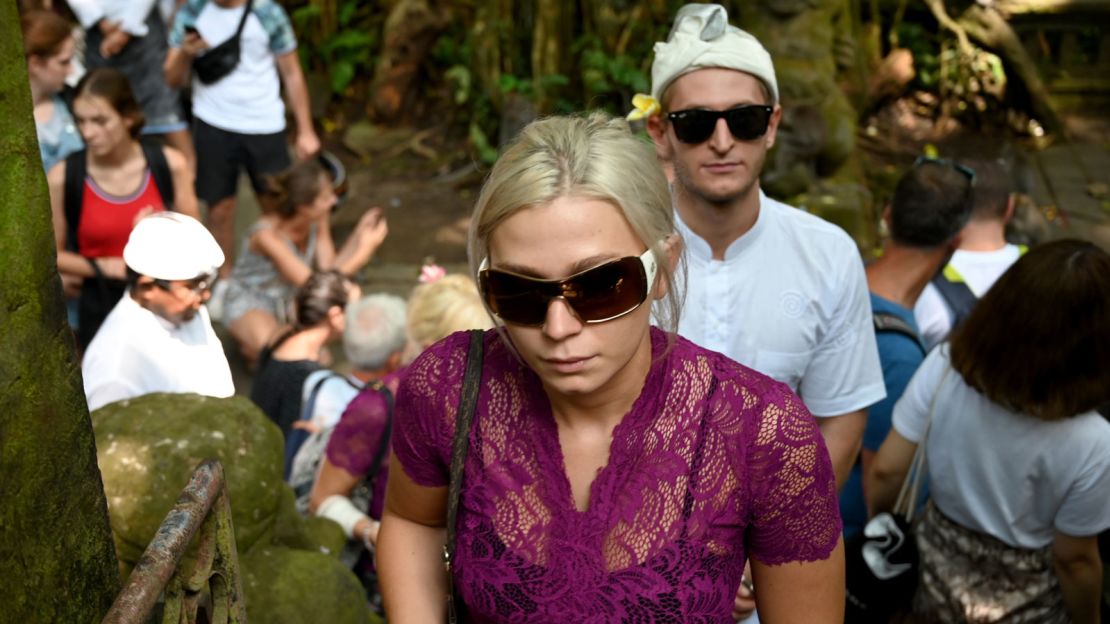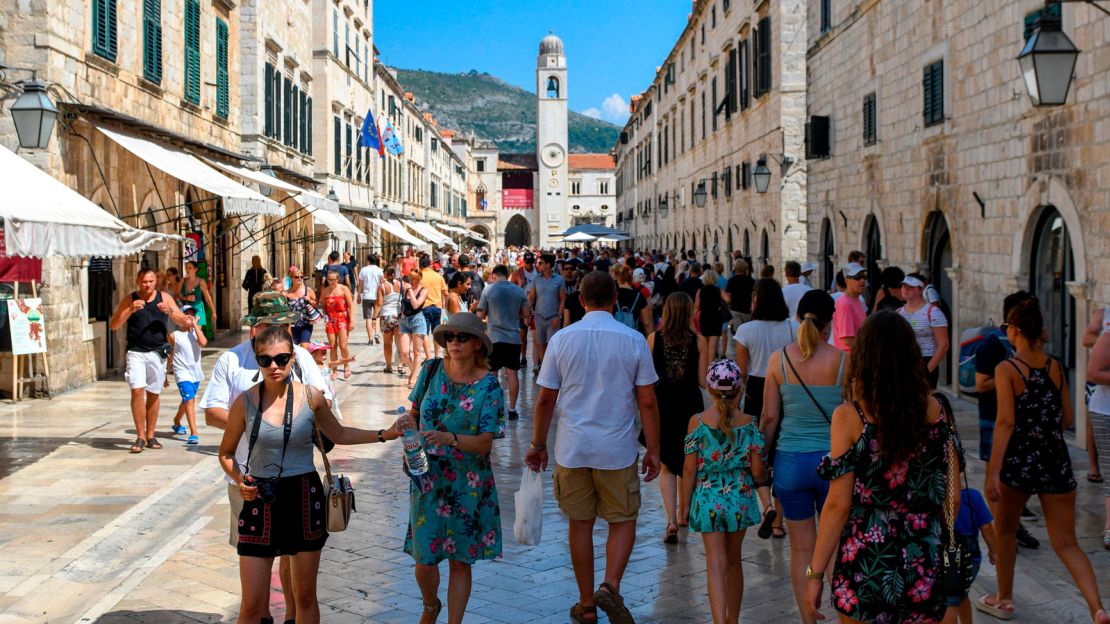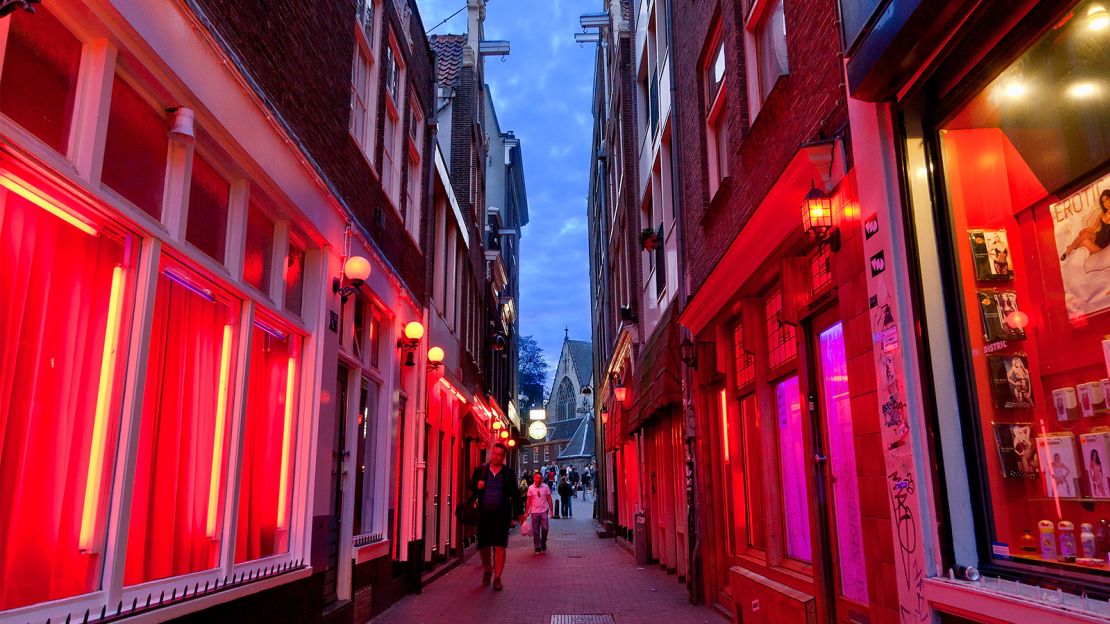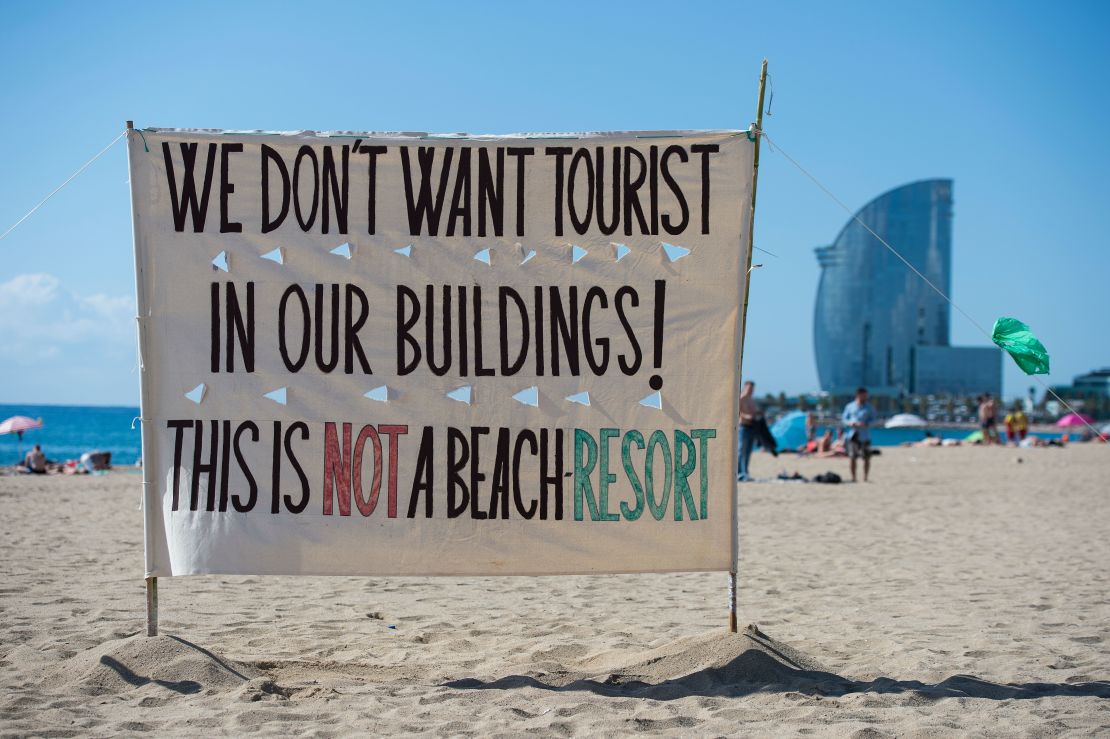Whether it’s skinny dipping in Venetian canals, chasing geishas down the street in Japan, or simply turning up in unsustainable numbers, tourists have been making headlines for all the wrong reasons recently.
Each week seems to bring new stories of travelers engaging in some type of transgression in popular or far-flung places.
While tourists were once seen as a highly coveted source of income by destinations – and still are in some cases – we appear to be living in an age where traveling has become a byword for trouble.
But has the behavior of tourists actually gotten worse over time, or is this simply an inevitable consequence of more and more us packing our bags and heading out into the big wide world?
There’s no doubt that tourism has increased dramatically in the last century. According to the United Nations World Tourism Organization (UNWTO,) there were a record 1.4 billion international tourist arrivals last year, a 6% increase on 2017.
Rewind to 1970 before the travel boom brought about by low-cost airlines, that number was just 166 million. Go back even further to 1950, it was a mere 25 million.
The role of tourism in the global economy has also gained significance. In 2018, it was worth about $1.7 trillion (£1.3 trillion,) or around 2% of the total global gross domestic product.
According to the UNWTO, France is the most popular country in the world to visit, followed by Spain, the US, China and Italy.
However, several destinations have been victims of their own popularity.
Excessive tourism has driven many locals away from Venice, and the Italian city, along with destinations such as Ibiza and Barcelona, has introduced a tourism tax to counteract some of the detrimental impacts, such as water shortages and waste pollution.
The seemingly non-stop instances of tourists gaining attention for unruly behavior hasn’t done much to help
However, professor Phaedra C. Pezzullo, tourism specialist and author of the book “Toxic Tourism” attests that these aren’t necessarily new issues.
“As long as humans have traveled, cultures have clashed and the environment has paid a price,” says Pezzullo.
“Access to touring farther distances by more people has increased. I’m not sure it [behavior] is worse.”
“There also are hopeful stories of collaboration and ecological restoration.”
Social media shaming

In August, YouTube vloggers Sabina Dolezalova and Zdenek Slouka, both from the Czech Republic, issued a public apology after receiving online backlash when Slouka was filmed lifting his girlfriend’s skirt and splashing water on her body inside the Beji Temple in the Sacred Monkey Forest in Ubud, Bali.
The scandal came just weeks after a clip of five Australian men running naked through the streets of the Indonesian island and urinating in public went viral
Both incidents provoked widespread criticism, with officials suggesting unruly tourists should be kicked out of Bali.
The Balinese tourism board says its government is in the process of preparing new legislation to regulate the behavior of travelers visiting the popular Indonesian island. But, it adds, there’s no indication that misdemeanors are on the up.
“Currently, there are no statistics to suggest that misconduct by tourists is increasing,” Herry Rachmat Widjaja, assistant deputy director for Tourism Crisis Management, Ministry of Tourism, Republic of Indonesia, tells CNN Travel.
“However, in this digital era, things can go viral easily, giving the impression that inappropriate conducts are increasing in number.
“This is actually an important reminder for the security forces and tourism industries to continue to educate tourists on respecting local culture and rituals.
“It’s possible that recent misconduct by tourists in Bali may relate to the individual’s lack of awareness and understanding of local wisdom and values of the Balinese people.”
Michael O’Regan, a senior lecturer at Bournemouth University and former assistant professor at the Institute for Tourism Studies, Macao, shares these sentiments, saying the trend for sharing these types of videos on social media only serves to worsen the relationship between tourists and locals.
“If a video goes viral, politicians are forced to act,” O’Regan tells CNN Travel, referencing an incident in Venice where two German tourists were fined 950 euros (around US$1,040) after being caught on camera making coffee on the steps of city’s landmark Rialto Bridge.
“Naming and shaming people weakens public support for tourists, creating an ‘us’ and ‘them.’
“Everyone wants this perfect tourist. But that creates a system where there are good tourists and bad tourists, which only makes things worse.”
Do codes of conduct work?

Rome is one of several major destinations to introduce guidelines for tourists in a bid to curb bad behavior.
In 2018, the Italian capital passed a law banning street drinking, organizing pub crawls and taking a dip in the city’s fountains.
Tourists are also prohibited from eating snacks in public places and sitting on the staircases of historic monuments such as the Spanish Steps.
Sara Verde, chief executive operator and founder of Rome Tour Guide, which arranges tours of Rome and the Vatican, believes these rules are necessary, saying the conduct of tourists has had a negative impact.
“In July and August, the city becomes a huge sewer and the people don’t care about any rules,” Verde tells CNN Travel. “It’s contributing towards destroying the city.”
Verde, who’s worked in the tourism industry for nearly two decades, has witnessed countless instances of abhorrent behavior from travelers.
Her horror stories involve a tourist who emptied their bladder shortly after getting off a bus to the Vatican and someone throwing up on one of the seats.
According to Verde, such exploits have taken the shine off Rome somewhat.
“Rome is a place where you can’t control the tourists any more,” she adds, stressing that the behavior does seems to have worsened over time.
Other destinations to introduce codes of conducts include New Zealand, which now gets visitors to pledge its “Tiaki Promise” of good behavior to deal with multiple problems associated with tourists – including careless driving, damaging camping practices and to ignorance of safety in the outdoors.
Some parts of Croatia have also opted to implement local codes of conduct.
The European country, which has a population of four million, saw just under 18.7 million arrivals in 2018, meaning it has more tourists per capita than many other tourist destinations.
Like Venice, Croatia has been massively impacted by cruise ship tourists, with 50,000 passenger arrivals expected in Dubrovnik this year alone.
Several of the country’s most popular destinations, including Split and Dubrovnik, have introduced “rules” or instructions for visitors amid concern of unruly behavior linked to alcohol use.
This includes requesting that appropriate attire be worn in historic areas, bans on drinking and congregating in public areas where alcohol consumption has been prohibited, as well as offering general guidance on the best ways to avoid causing offense.
“In general, codes of conduct are a means of informing our visitors as to the expectations of the destination in terms of acceptable behavior,” says Ina Rodin, director of North America at the Croatian National Tourist Office.
Cultural misunderstandings

“This is usually well-received and there has been limited resistance with regard to compliance.”
She goes on to stress that, while the country has experienced “isolated issues with unruly tourists,” Croatia doesn’t consider the behavior of tourists a serious problem at present.
“Usually these incidents are related to abuse of alcohol and ensuing behavior related to drunk and disorderly conduct,” she says.
While codes of conducts have been rolled out in some of its most popular destinations, Croatia isn’t planning to issue them nationally.
“At the national level we would say that the best way to deal with this is to work on public awareness and education about respecting the destination one is visiting,” adds Rodin.
O’Regan agrees that communicating with tourists and educating them on local culture is the best course of action.
He says there’s no evidence to suggest codes of conduct actually work, pointing out that many tourists won’t even be aware of them in the first instance.
“I think we’re going down the wrong road,” he says. “We can’t expect every single tourist to be aware of every cultural practice in the place they’re traveling to.
“Tourism was meant to educate. Travelers would go to a different destination, adapt to different cultures and come back somewhat changed.”
He stresses that simply placing signs in taxis or at the airport or issuing etiquette guides can prove effective.
For instance, Japanese city Kyoto recently introduced a smartphone update to rein in impolite tourists after reports of travelers lying down in the street to take photos and chasing geishas.
Launched by the Land, Infrastructure, Transport and Tourism Ministry in cooperation with the Kyoto city government, the pilot project involves pushing etiquette reminders through city-sponsored tourist mobile apps and portable electronics rented from local hotels.
The trial, which began in late September, will run around Hanamikoji street in the Gion district until the end of the year.
“No one walks into the Vatican without knowing you need to cover your shoulders,” says Pezzullo, stressing the tourism industry should be taking more responsibility for the behavior of travelers.
While many initiatives, including the Kyoto smartphone project, provide conduct instructions for tourists once they arrive, Pezzullo feels they should come into effect earlier than this.
“Educational outreach about expectations before tourists even arrive can help reduce tensions,” she adds. “We can’t expect ready made, perfect tourists as soon as they land at a destination. It’s a learning process.”
Being branded an unruly tourist can be damaging, as was the case for Dolezalova and Slouka, who took part in a ritual purification ceremony by way of apology for their actions.
Some countries have gone to great lengths to prevent their citizens from being named and shamed in such a manner.
After a spate of negative stories regarding Chinese tourists, the government went as far as to issue citizens with a code of conduct manual named, “Guide to Civilized Tourism and Travel.”
The 64-page book, released in 2013, advised against spitting and queue-jumping as well as lying down in public or removing your shoes and socks.
But while we can certainly make a case for cultural misinterpretations in some instances, this doesn’t explain all incidents of tourists acting out.
Lower inhibitions

According to tourism expert Dr. Peter E. Tarlow, some travelers are likely to behave out of character while in a new destination due to the excitement and the anonymity of being somewhere seemingly unconnected to their everyday lives.
“Being away from home, travelers tend to lower their inhibitions, standards and behavior,” he wrote in his 2018 book “Tourism-Oriented Policing and Protective Services.”
“Because many travelers enjoy their feeling of anonymity, they are more willing to engage in rude, semi-legal or even illegal activities about which they would not engage at home.
“This lowering of inhibitions can range from minimal issues such as the use of foul language to issues of drunkenness or the use of illegal drugs.
“The problem of low inhibitions is one that runs throughout almost all aspects of tourism policing.”
This certainly seems to have been the case for Amsterdam, which became synonymous with bachelor parties, drunken tourists and binge-drinking as travelers took advantage of the city’s freedom and liberalism.
After numerous complaints from locals, the Dutch capital opted to introduce on-the-spot fines for drunkenness or excessive noise and banned its popular beer bikes to clamp down on unruly visitors.
Earlier this year, the city government also announced it will end tours of the Red Light District in central Amsterdam, amid concerns that sex workers are being treated as a tourist attraction.
“Amsterdam is an attractive city and the number of visitors is growing,” a spokesperson from amsterdam&partners, a nonprofit organization focused on building the reputation of the Amsterdam metropolitan area, tells CNN Travel.
“This attraction has positive sides, but there is also a downside: some visitors cause a nuisance by being too loud or by urinating or being intoxicated in public.
“We are seeing an increase in litter, which can be an extreme nuisance in some areas. This affects the quality of life in certain neighborhoods.”
in April, the city launched the Enjoy & Respect campaign in order to tackle offensive behavior from tourists in the city, and amsterdam&partners feels the message is getting through.
“We make it clear to visitors that behavior like this is unacceptable and has consequences,” says the spokesperson.
“Structurally influencing the perception that not everything is tolerated in Amsterdam will lead to a behavioral change in the long term.”
Backlash from locals

Amsterdam is now so popular with travelers, officials have opted to stop advertising it as a tourist destination.
The city has also raised tourism tax by an extra three euros per person – about US$3 – per night for travelers staying overnight in hotels and imposed stricter rules on Airbnb in order to combat the problem.
“Overcrowding can also cause considerable nuisance, especially if there are too many pedestrians, cyclists, and motorists in a given place at a given time,” adds
the spokesperson, explaining that this has also had a negative impact on the lives of local residents.
Of course, Amsterdam isn’t the only destination in which mass tourism has had a devastating impacted on its residents’ quality of life.
Every year, around 1,000 locals leave Venice, as the cost of living increases due to rising numbers of tourists.
In 2017, 150,000 people marched against the growing number of tourists flocking to Barcelona and the popularity of AirBnB, which has led to a housing shortage in the city.
O’Regan feels that locals should have more of a say in how tourism is managed in different destinations as they are the ones most affected.
“Politicians and advisers need to look past numbers and ask locals what’s really going on,” he says.
“Before thinking about codes and practices, entrance fees or even banning coaches from city centers, they need to fully assess the impact.
“Is having cruise ports at places like Venice and Dubrovnik adding anything to anyone’s quality of life, for example?”
Of course, being considered a problem by various destinations isn’t exactly encouraging for prospective tourists.
Judy Randall, CEO of travel and tourism research specialist company Randall Travel Marketing, feels that some of the perceived unruly behavior is merely a reaction to a shift in the way travelers are treated now that tourism is booming across the world.
“I firmly believe it all lives in that front line – giving visitor effective orientation and information,” Randall says.
“Treat them [travelers] well, and they will reward you in kind. Leave them solely to their own devices and they will be irritated, and behave poorly.
“If you think about air travel – this is exactly the case. Most people would agree that those air travelers in first class behave better than in economy.
“Is it because they are actually different types of people, or because they are treated better from start to finish? I think they [travelers] miss being treated well.”
Although there’s no clear evidence that travelers are behaving any worse than before.
As tourism numbers continue to increase, it seems apparent that there’s a growing discontent between some destinations and the people that travel there.
So if codes of conducts aren’t necessarily the answer, how can destinations effectively communicate with travelers without completely alienating them?
“I think a good sense of humor, willingness to listen and the desire to change matter most,” says Pezzullo.
“We all can offend people in our own cultures, let alone other cultures with which we are less familiar.
“To improve the tourist industry, we need to make sure local communities have a place at the table, not just multinational corporations.
“Touring as a practice is pervasive, demonizing it won’t help anyone.”












